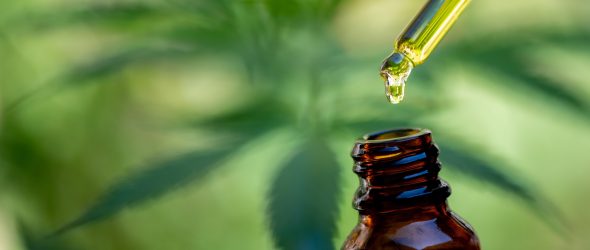
(EKKAPON/AdobeStock)
If you’re open to taking your coffee decaf or drinking low-alcohol beer, the idea of lightening your cannabis dose is probably welcome. Unsurprisingly, today’s cannabis consumer generally isn’t looking to get stoned to the point of paralysis. But pot has never been as potent as it is today. According to a 2019 study, mean Δ9-THC concentration in cannabis has increased almost twofold in the past decade or so, from 8.9% in 2008 to 17.1% in 2017.
Rather than resign themselves to disorientating head highs, consumers are experimenting with novel ways to get the most out of their hit, with less … of a hit. As growing research confirms that a little weed goes a long way, both cannasseurs and researchers alike are looking to enhance the beneficial outcomes of cannabis while minimizing detrimental ones with very small doses.
Variations on the microdosing theme
The concept of lightening the load isn’t a new one. Microdosing, a process used in drug development to assess the effects of a minute dose of a substance on the body, first became popular and absorbed into cannabis culture several years back. Savvy consumers grew aware of the benefits of small doses that served therapeutic benefits without the side of anxiety or paranoia. Microdosing also enables the canna-curious to dip their toes into the water.
While microdosing represents one method of facilitating a more grounded cannabis experience, other variations have also sprung forth—“lite” products, which allow novice consumers to experience the joys of weed without its potential pitfalls. For example, the Rookie Cookie, with 10mg of CBD and 10mg of THC, allows you to demolish an entire cookie, enjoy the buzz, and remain lucid enough to function.
Similar to CBD oil, marijuana lite products promote the feeling of relaxation, or a body high without the head high. Most critically, they take the guesswork out of dosing edibles, so there’s no longer a need to carve an infused chocolate bar into twenty pieces.
Italy has even seen the meteoric rise of a “cannabis light” movement. Cannabis light, which became legal in December 2019, refers to cannabis sativa plant derivatives with levels of 0.6% THC or less, facilitating a super mild, barely-there buzz. Italian consumers can enjoy cannabis light in the form of infused pasta, olive oil, and gelato, along with buds.
Ultra-low doses: When dosing gets really low
While microdosing and cannabis lite are pitched at consumers, researchers have also been exploring the therapeutic potential of very low doses in the laboratory. Enter ultra-low dosing.
According to Dr. Stacia Woodcock, clinical pharmacist and Director of Education at The International Research Center on Cannabis and Health, ultra-low dosing has its roots in hormesis, the concept that a compound can have directly opposite effects at high versus low doses—also known as biphasic dose-dependency.
“Homeopathic medicine is based on this concept. Compounds which can be toxic or cause undesirable effects at standard doses are diluted down by several levels of magnitude, at which point the highly diluted form is then used to prevent those same symptoms,” explained Woodcock.
“A simpler way of explaining this is to consider allergy shots. A large ‘dose’ of pollen from the environment introduced into the body causes horrible allergy symptoms, but a highly diluted form of that same pollen injected into the body can actually help the body build an immune response to prevent those allergy symptoms from occurring,” she said.
In the case of cannabis, ultra-low dosing is several orders of magnitude smaller than what is considered a microdose. “For example, if a microdose is considered to be 2mg of THC, an ultra-low dose would be 0.02-0.2mg of THC,” said Woodcock. “These are not hard numbers, however, because we do not have any clinical studies in humans that clearly delineate the lines between ‘dosing,’ ‘microdosing,’ or ‘ultra-low dosing.’”
While it may sound like semantics, there’s ample evidence to suggest it’s not. More often than not, the key to optimizing one’s experience with weed is experimenting with doses incrementally and noting nuance until the perfect balance is struck.
Studies on ultra-low dosing
In the past ten years, a range of studies have emerged exploring the effects of ultra-low doses of THC. Findings to date indicate that ultra-low doses can modify brain plasticity and induce long-term behavioral and developmental effects.
Several early studies suggested that ultra-low doses of THC may cause mild cognitive impairment. In a 2007 study, a single injection of an ultra-low dose of THC (0.001mg/kg) in mice had a detrimental effect on memory and learning that lasted up to four months. Similar results were reported in a 2010 study where a single ultra-low dose caused behavioral deficits in mice that lasted up to five months.
According to the above 2010 study’s lead author, Dr. Haitham Amal, principal investigator at The Laboratory of Neuromics, Cell Signaling and Translational Medicine of The Institute for Drug Research at The Hebrew University of Jerusalem, the potential for ultra-low doses to issue protective benefits outweighs the mild impairment.
“We found significant differences between the control dose and the treated group which indicated the ultra-low dose can affect memory and spatial learning, but this effect is not severe, it doesn’t pose severe damage,” explained Amal. “In our follow-up work, we used this ultra-low dose, which has a specific molecular mechanism different to a high dose, to see whether it could protect mice from epileptic seizures and mechanical head injuries. We carried out these experiments and found that the ultra-low dose conferred a protective value in mice models.”
According to Amal, the ultra-low dose has two phases. The advantages that can be gained from the ultra-low dose in the treatment of diseases overcome the disadvantages or delicate damage that the ultra-low dose may inflict.
Additionally, a subsequent animal study from 2014 revealed that ultra-low doses of THC can shield the brain from cognitive damage caused by neuroinflammation. The authors report that ultra-low doses could potentially be used to address neuroinflammatory conditions, including neurodegenerative diseases.
For Dr. Amal, long-term, ultra-low dosing may support individuals experiencing neurological assaults from disorders such as Alzheimer’s, multiple sclerosis, autism spectrum disorder, and Parkinson’s. “My work was on a single administration of ultra-low doses, so I’m hypothesizing here,” stated Amal. “While chronic ultra-low doses will negatively affect memory, spatial learning, and biochemical changes, I think using low doses long-term for the treatment of these neurological disorders could be beneficial.”
Amal’s hypothesis has been echoed in a 2019 review conducted by expert Dr. Yosef Sarne. Sarne reports that ultra-low doses of THC have been shown to rescue cognitive function in models of brain injury in mice, including seizures, hypoxia, anesthesia, neurotoxicity, and neuroinflammation. THC’s anti-inflammatory properties also help combat cognitive deterioration in neurodegenerative disorders and slow down age-related decline.
Compellingly, the protective effects conferred by ultra-low doses of THC were not confined to the brain, but also noted in the kidneys, liver, and heart.
Ultra-low dosing for beginners
If you’re curious to try ultra-low dosing yourself, Sarne, in the above study, recommends a dose of 0.0002 mg/kg in humans, which works out to about 0.014mg (or 14 micrograms) for an individual of 150 lbs (70 kg). This dose is 100 times lower than the standard threshold (1-2mg of THC), which is when the intoxicating effects of THC would begin to kick in.
Woodcock recommends tinctures and oral solutions when it comes to experimenting with ultra-low dosing. “They’re easy to dilute down and measure to accurately administer the dose. As a clinician, I would only recommend utilizing cannabis products from a legal source that is regulated and tested in a way that ensures the accuracy of the dose being utilized.”



